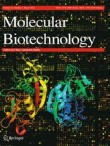
Abstract
Andrographis paniculata 1-deoxy-D-xylulose-5-phosphate synthase (ApDXS) gene (GenBank Accession No MG271749.1) was isolated and cloned from leaves for the first time. Expression of ApDXS gene was carried out in Escherichia coli Rosetta cells. Tissue-specific ApDXS gene expression by quantitative RT-PCR (qRT-PCR) revealed maximum fold expression in the leaves followed by stem and roots. Further, the differential gene expression profile of Jasmonic acid (JA)-elicited in vitro adventitious root cultures showed enhanced ApDXS expression compared to untreated control cultures. A. paniculata 3-hydroxy-3-methylglutaryl-coenzyme A reductase (ApHMGR) gene expression was also studied where it was up-regulated by JA elicitation but showed lower expression compared to ApDXS. The highest expression of both genes was found at 25 µm JA elicitation followed by 50 µm. HPLC data i ndicated that the transcription levels were correlated with increased andrographolide accumulation. The peak level of andrographolide accumulation was recorded at 25 μM JA (9.38-fold) followed by 50 µM JA (7.58-fold) in elicitation treatments. The in silico generated ApDXS 3D model revealed 98% expected amino acid residues in the favored and 2% in the allowed regions of the Ramachandran plot with 92% structural reliability. Further, prediction of conserved domains and essential amino acids [Arg (249, 252, 255), Asn (307) and Ser (247)] involved in ligand/inhibitor binding was carried out by in silico docking studies. Our present findings will generate genomic information and provide a blueprint for future studies of ApDXS and its role in diterpenoid biosynthesis in A. paniculata.



Δεν υπάρχουν σχόλια:
Δημοσίευση σχολίου